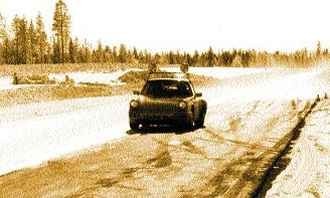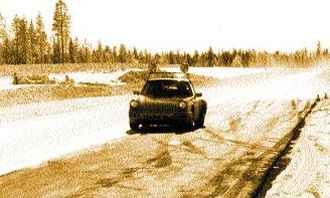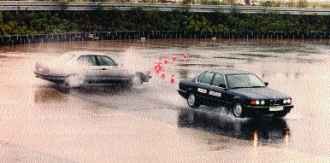
ABS 25 years
 Although the first cars were much slower than they are today, what happened was that instead of stopping, the car moved on with locked wheels.
Although the first cars were much slower than they are today, what happened was that instead of stopping, the car moved on with locked wheels.
Problems with locking wheels when braking are almost as old as cars. Although the first cars were much slower than they are today, what happened was that instead of stopping, the car moved on with locked wheels.
|
Testing the first ABS systems - left road surface with good grip, slippery on the left. |
Over attempts to avoid such a situation, designers have been racking their brains since the beginning of the 1936 century. The first "anti-lock brake device" Bosch applied for a patent back in 40. However, the systems have not been mass-produced for more than XNUMX years. However, the following prototype systems had many drawbacks, were too slow and too expensive for mass production.
In 1964, Bosch began testing the ABS system. Two years later, the first results were achieved. The cars had shorter braking distances, better handling and cornering stability. The experience accumulated at that time was used in the construction of the ABS1 system, elements of which are still used in modern systems today. ABS-1 began to perform its tasks in 1970, but it was too complicated - it contained 1000 analog elements. In addition, their durability and reliability were not yet sufficient to put the system into production. The introduction of digital technology has reduced the number of elements to 140. However, even in modern systems there are still elements that were in ABS 1.
|
Late 70s - ABS comes to Mercedes. |
As a result, only the second generation of ABS, after 14 years of research, turned out to be so effective and safe that it was decided to put it into production. However, it was an expensive decision. When it was introduced in 1978, it was given to luxury limousines - first the Mercedes S-Class and then the BMW 7 Series. Nevertheless, a million ABS systems were produced in 8 years. in 1999, the number of ABS systems produced exceeded 50 million units. Over the past 25 years, the cost of manufacturing ABS of the next generations has decreased so much that today this system is offered even for small cheap cars. ABS currently has 90 percent. sold in Western Europe. All cars must have it since mid 2004.
Engineers are constantly striving to simplify the system, reduce the number of components (which will increase reliability) and reduce weight.
The functions and capabilities of the system are also being developed, which now allows for electronic distribution of brake force between the axles.
|
When braking in a corner, a vehicle without ABS slides faster. |
ABS also became the basis for the development of systems such as ASR, introduced in 1987, to prevent skidding during acceleration and the electronic traction control system ESP. This solution, introduced by Bosch in 1995, improves stability not only when braking and accelerating, but also in other situations, such as when driving around curves on slippery surfaces. It can not only slow down individual wheels, but also reduces engine power in situations where there is a risk of skidding.
How ABS works
Each wheel has sensors that report the risk of wheel blockage. In this case, the system relieves pressure in the brake line to the blocking wheel. When it starts spinning normally again, the pressure returns to normal and the brakes begin to brake the wheel again. The same algorithm is repeated each time the wheel locks up when the driver applies the brakes. The whole cycle is very fast, hence the sensation of pulsation, as if there were short strokes in the wheels.
He doesn't work miracles
On a slippery road, a car equipped with ABS will stop earlier than a car without this system, which "slips" part of the braking distance on locked wheels. However, on a road with good grip, a car with ABS stops further than a car that scratches the tires of locked wheels, leaving a black rubber trail behind. The same applies to loose surfaces such as sand or gravel.


